75 found, showing page 1 of 5
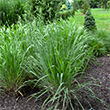
Height: 5 feet
Spread: 3 feet
Sunlight: full sun
Hardiness Zone: 3a
Description:
A clump forming variety producing tall blue-green leaf blades which turn gold in fall and retain it through the winter; long, feathery panicles appear above the foliage in late summer, turning copper in fall; an excellent vertical accent
Ornamental Features:
Indian Steel Indian Grass is primarily grown for its highly ornamental fruit. The coppery-bronze seed heads are carried on showy plumes displayed in abundance from early to late fall. It has masses of beautiful panicles of buttery yellow flowers held atop the stems in late summer, which are most effective when planted in groupings. Its grassy leaves are bluish-green in color with showy steel blue variegation. The foliage often turns gold in fall. The tan stems can be quite attractive.
Landscape Attributes:
Indian Steel Indian Grass is an herbaceous perennial grass with an upright spreading habit of growth. Its relatively fine texture sets it apart from other garden plants with less refined foliage.
This is a relatively low maintenance plant, and is best cut back to the ground in late winter before active growth resumes. It has no significant negative characteristics.
Indian Steel Indian Grass is recommended for the following landscape applications:
- Mass Planting
- General Garden Use
- Planting & Growing
Indian Steel Indian Grass will grow to be about 4 feet tall at maturity, with a spread of 3 feet. It tends to be leggy, with a typical clearance of 1 foot from the ground, and should be underplanted with lower-growing perennials. It grows at a medium rate, and under ideal conditions can be expected to live for approximately 15 years. As an herbaceous perennial, this plant will usually die back to the crown each winter, and will regrow from the base each spring. Be careful not to disturb the crown in late winter when it may not be readily seen!
This plant should only be grown in full sunlight. It is very adaptable to both dry and moist locations, and should do just fine under typical garden conditions. It is not particular as to soil type or pH. It is highly tolerant of urban pollution and will even thrive in inner city environments. This is a selection of a native North American species. It can be propagated by division; however, as a cultivated variety, be aware that it may be subject to certain restrictions or prohibitions on propagation.
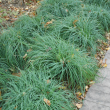
Height: 8 inches
Spread: 12 inches
Sunlight: partial shade, full shade
Hardiness Zone: 3a
Other Names: Oak Sedge
Description:
This shade loving native sedge features soft, arching semi-evergreen foliage; excellent in rock gardens, containers, or as a groundcover; prefers part shade and dry to medium moisture; tough and adaptable
Ornamental Features:
Pennsylvania Sedge is primarily valued in the garden for its cascading habit of growth. Its grassy leaves remain forest green in color throughout the season.
Landscape Attributes:
Pennsylvania Sedge is an herbaceous perennial grass with a shapely form and gracefully arching stems. It brings an extremely fine and delicate texture to the garden composition and should be used to full effect.
This is a relatively low maintenance plant, and is best cleaned up in early spring before it resumes active growth for the season. It has no significant negative characteristics.
Pennsylvania Sedge is recommended for the following landscape applications:
- Mass Planting
- Rock/Alpine Gardens
- Border Edging
- General Garden Use
- Groundcover
- Container Planting
- Planting & Growing
Pennsylvania Sedge will grow to be about 8 inches tall at maturity, with a spread of 12 inches. Its foliage tends to remain low and dense right to the ground. It grows at a slow rate, and under ideal conditions can be expected to live for approximately 10 years. As an herbaceous perennial, this plant will usually die back to the crown each winter, and will regrow from the base each spring. Be careful not to disturb the crown in late winter when it may not be readily seen!
This plant does best in partial shade to shade. It prefers to grow in average to dry locations, and dislikes excessive moisture. It is not particular as to soil type or pH. It is somewhat tolerant of urban pollution. Consider applying a thick mulch around the root zone in both summer and winter to conserve soil moisture and protect it in exposed locations or colder microclimates. This species is native to parts of North America. It can be propagated by division.
Pennsylvania Sedge is a fine choice for the garden, but it is also a good selection for planting in outdoor pots and containers. It is often used as a 'filler' in the 'spiller-thriller-filler' container combination, providing the canvas against which the thriller plants stand out. Note that when growing plants in outdoor containers and baskets, they may require more frequent waterings than they would in the yard or garden.
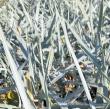
ELYMUS 'BLUE DUNE' 1G
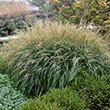
'Adagio' Maiden Grass | Pinkish blooms. Upright clumping grass. Self-seeding. USDA 5-9
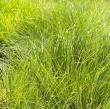
Height: 6 inches
Spread: 18 inches
Sunlight: partial shade full shade
Hardiness Zone: 3a
Description:
A weeping, perennial native sedge that forms graceful, mounded tufts of very fine textured, deep green, threadlike foliage; thrives in dry to mesic woods and does best with some shade; perfect for massing, slopes, or as a shade groundcover
Ornamental Features:
Appalachian Sedge is primarily valued in the garden for its cascading habit of growth. Its attractive threadlike leaves remain forest green in color throughout the season.
Landscape Attributes:
Appalachian Sedge is an herbaceous perennial grass with a shapely form and gracefully arching stems. It brings an extremely fine and delicate texture to the garden composition and should be used to full effect.
This is a relatively low maintenance plant, and is best cleaned up in early spring before it resumes active growth for the season. It has no significant negative characteristics.
Appalachian Sedge is recommended for the following landscape applications:
- Mass Planting
- Rock/Alpine Gardens
- Border Edging
- Groundcover
- Naturalizing And Woodland Gardens
- Container Planting
Planting & Growing:
Appalachian Sedge will grow to be only 6 inches tall at maturity, with a spread of 18 inches. Its foliage tends to remain low and dense right to the ground. It grows at a medium rate, and under ideal conditions can be expected to live for approximately 10 years. As an herbaceous perennial, this plant will usually die back to the crown each winter, and will regrow from the base each spring. Be careful not to disturb the crown in late winter when it may not be readily seen!
This plant does best in partial shade to shade. It prefers to grow in average to dry locations, and dislikes excessive moisture. It is considered to be drought-tolerant, and thus makes an ideal choice for a low-water garden or xeriscape application. This plant should not require much in the way of fertilizing once established, although it may appreciate a shot of general-purpose fertilizer from time to time early in the growing season. It is not particular as to soil type or pH. It is somewhat tolerant of urban pollution. This species is native to parts of North America. It can be propagated by division.
Appalachian Sedge is a fine choice for the garden, but it is also a good selection for planting in outdoor pots and containers. It is often used as a 'filler' in the 'spiller-thriller-filler' container combination, providing a canvas of foliage against which the thriller plants stand out. Note that when growing plants in outdoor containers and baskets, they may require more frequent waterings than they would in the yard or garden.
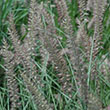
Dark, smoky rose-purple flower spikes. Deep green arching foliage. USDA 5-8
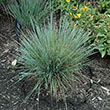
Showy seed heads. Blue-green foliage. Upright. Native. USDA 3-9
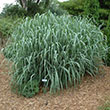
White, feathery plumes are tinged with purple. Rich-green foliage. USDA 5-9
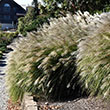
Copper red blooms. Narrow green foliage. Arching clump. USDA 5-9
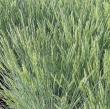
Height: 8 inches
Spread: 12 inches
Sunlight: full sun, partial shade
Hardiness Zone: 2b
Other Names: Festuca ovina var. glauca
Description:
A dwarf ornamental grass featuring bright silver-blue foliage; neat mounds of densely tufted leaves stay blue all season long; tall upright tan plumes sway in the breeze; drought tolerant once established, great for containers, beds and borders
Ornamental Features:
Elijah Blue Fescue is primarily valued in the garden for its interestingly mounded form. Its attractive grassy leaves remain blue in color throughout the year. The tan seed heads are carried on spikes from mid summer to late fall.
Landscape Attributes:
Elijah Blue Fescue is an herbaceous evergreen perennial grass with a mounded form. It brings an extremely fine and delicate texture to the garden composition and should be used to full effect.
This is a relatively low maintenance plant, and is best cleaned up in early spring before it resumes active growth for the season. It has no significant negative characteristics.
Elijah Blue Fescue is recommended for the following landscape applications:
- Rock/Alpine Gardens
- Border Edging
- General Garden Use
- Naturalizing And Woodland Gardens
- Container Planting
Planting & Growing:
Elijah Blue Fescue will grow to be about 8 inches tall at maturity, with a spread of 12 inches. Its foliage tends to remain low and dense right to the ground. It grows at a medium rate, and under ideal conditions can be expected to live for approximately 8 years. As an evegreen perennial, this plant will typically keep its form and foliage year-round.
This plant does best in full sun to partial shade. It prefers to grow in average to dry locations, and dislikes excessive moisture. It is considered to be drought-tolerant, and thus makes an ideal choice for a low-water garden or xeriscape application. It is not particular as to soil type or pH. It is highly tolerant of urban pollution and will even thrive in inner city environments. This is a selected variety of a species not originally from North America. It can be propagated by division; however, as a cultivated variety, be aware that it may be subject to certain restrictions or prohibitions on propagation.
Elijah Blue Fescue is a fine choice for the garden, but it is also a good selection for planting in outdoor pots and containers. It is often used as a 'filler' in the 'spiller-thriller-filler' container combination, providing a canvas of foliage against which the thriller plants stand out. Note that when growing plants in outdoor containers and baskets, they may require more frequent waterings than they would in the yard or garden.
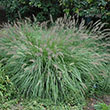
Tan bottlebrush blooms. Arching dark green foliage. Mounding. USDA 6-9
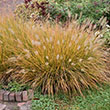
White blooms. Compact. Clumping green foliage. USDA 5-9
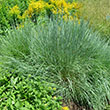
Upright clumps of slender, flat, linear bluish green leaves. Purplish-bronze blooms. Tolerates black walnut. USDA 3-9
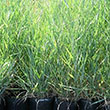
PANICUM 'PRAIRIE SKY' 1G
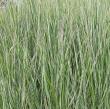
CALAMAGROSTIS 'HELLO SPRING' 1G
75 found, showing page 1 of 5